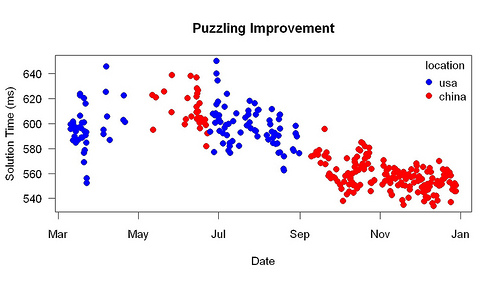A month ago I posted this graph, which shows how long I needed to type the answer to simple arithmetic problems (7-5, 4*1, 9+0). I tested myself with about 40 problems once or twice per day. Because I’d been doing this for a long time, I no longer improved due to practice. Then, at the end of July 2010, I started improving again.
In September I moved from Berkeley to Beijing. I was worried that in Beijing my scores would get worse. Perhaps I couldn’t get good flaxseed oil or butter. Maybe I would suffer from the air pollution. Maybe I would eat contaminated food. But my scores got better in Beijing.
When I eventually noticed the improvement, I wondered what I was doing differently. Obviously my diet and my life were a lot different in Beijing than Berkeley. Was I eating more walnuts in Beijing? I stopped eating walnuts and my scores didn’t get worse. So it wasn’t walnuts. The most plausible differences I could think of were: 1. Less aerobic exercise in Beijing. 2. Less vitamins in Beijing. 3. Warmer in Beijing. I collected data that implied that shower temperature matters — and I can take warmer showers in Beijing than in Berkeley.
All of these proposed explanations implied that the crucial difference was Berkeley versus Beijing. But the improvement started in Berkeley — around the end of July. That was a problem. Recently I realized there was another possible explanation. In Berkeley I had had an amalgam mercury-containing filling replaced with a non-metallic filling. Not because I had symptoms of mercury poisoning, but because it seemed prudent.
I checked my records to see when I had the filling replaced. It was July 28 — right when the improvement started. To my shock, reduction in mercury exposure is now the most plausible explanation of the improvement. Two tests of this explanation are coming up: 1. When I return to Berkeley, will my reaction times go up? 2. When I have more amalgam fillings replaced, will my reaction times go down?
If it turns out that reduction in mercury exposure is the correct explanation, this will be important. I have an average number of fillings. I’d guess that half of Americans have as many amalgam fillings as I did. And — if the mercury explanation is correct — this arithmetic test is a sensitive measure of mercury poisoning. Over the last few years, before the filling was removed, I’d had six hair tests done, all from the same reputable lab. They showed that my mercury level was moderately high, perhaps 75th percentile. Not very worrisome.
I changed dentists because my old dentist made a terrible mistake: he put a gold filling next to an amalgam one. Putting one metal next to a different one is an elementary mistake. Contact of different metals creates an electric current (as Galvani discovered) and releases mercury. (So although I have a normal number of fillings perhaps I have more mercury exposure.) I stopped going to him for any dental work. The last time I went there for a cleaning, I was given a booklet (“we must give you this”) about the many sorts of dental materials — mercury amalgams plus several new ones. The purpose seems to be to tell people mercury amalgams aren’t dangerous (this was stressed) yet get them to choose other materials in the future — mercury amalgams are just one of several possible choices. The controversy about the safety of mercury amalgams is covered here. Sweden, Denmark, and Norway have banned mercury amalgams. The ban began 2008.
